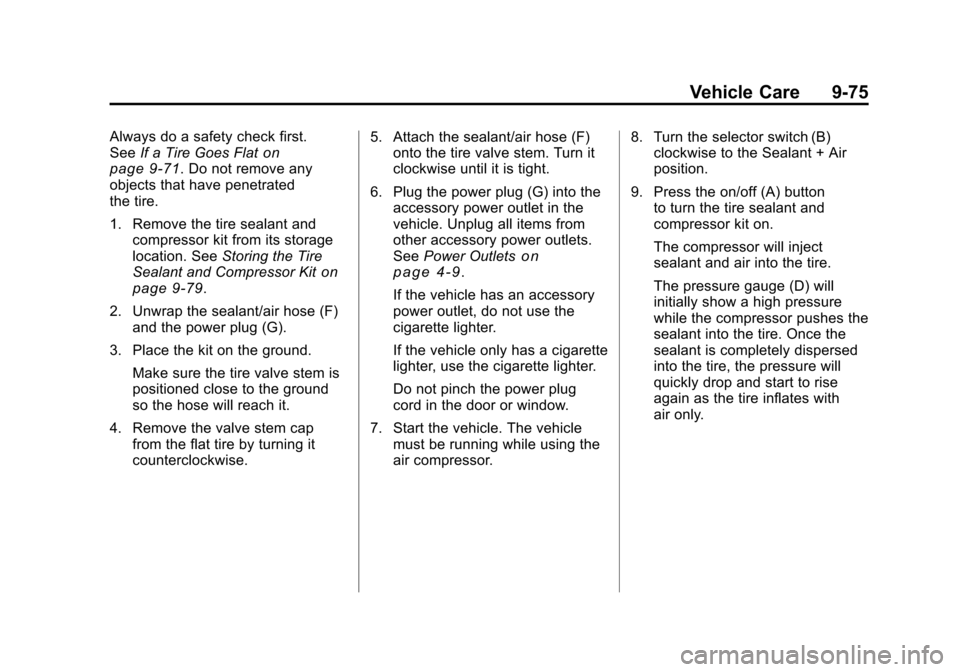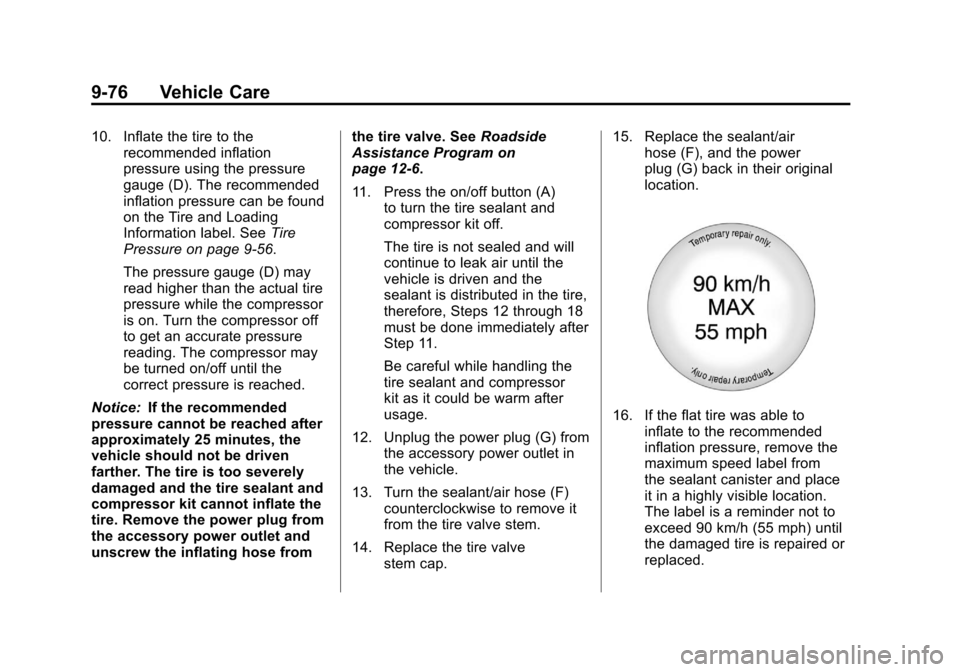Page 272 of 378
Black plate (40,1)Chevrolet Camaro Owner Manual - 2010
9-40 Vehicle Care
Fog Lamps
The base model vehicle may have
fog lamps which would be located
on the fascia.
To replace one of these bulbs:
1. Locate the bulb assembly underthe front fascia.
2. Disconnect the electrical connector from the bulb
assembly and pull out the
bulb assembly. 3. Push in the new bulb assembly
to lock it into place.
4. Reconnect the electrical connector to the bulb assembly.
The up–level vehicle will not be
equipped with fog lamps.
Taillamps, Turn Signal,
and Stoplamps
To replace a taillamp, turn signal,
or stoplamp bulb:
1. Open the trunk. See Trunk
on
page 1‑8.
2. Remove the close out panel retainers to gain access to the
bulb socket connectors.
3. Turn the bulb socket counterclockwise to remove it.
4. Pull the old bulb straight out of the bulb socket.
5. Push the new bulb straight into the bulb socket until it clicks.
6. Turn the bulb socket clockwise to reinstall.
Page 273 of 378

Black plate (41,1)Chevrolet Camaro Owner Manual - 2010
Vehicle Care 9-41
License Plate Lamp
To replace one of these bulbs:
1. Unclip the license plate lampfrom the facia opening.
2. Pull the license plate lamp down through the facia opening.
3. Turn the bulb socket counterclockwise and pull the
bulb straight out of the lamp
socket.
4. Install the new bulb. 5. Push the bulb straight into the
socket and turn clockwise to
reinstall.
6. Reinstall the license plate lamp by lifting it through the facia
opening until the clip is in place.
Replacement Bulbs
Exterior Lamp Bulb
Number
Daytime Running
Lamp (Up-level
vehicles) P13W
Fog Lamp PS24W
Front Park and Turn
Signal Lamp 3457NAK
Halogen Headlamp H13
License Plate Lamp W5W
Rear Turn Signal
and Taillamps 3157K
For replacement bulbs not listed
here, contact your dealer.
Electrical System
Electrical System
Overload
The vehicle has fuses and circuit
breakers to protect against an
electrical system overload.
When the current electrical load is
too heavy, the circuit breaker opens
and closes, protecting the circuit
until the current load returns to
normal or the problem is fixed.
This greatly reduces the chance
of circuit overload and fire caused
by electrical problems.
Fuses and circuit breakers protect
the following in the vehicle:
.Headlamp Wiring
.Windshield Wiper Motor
.Power Windows and other
Power Accessories
Page 307 of 378

Black plate (75,1)Chevrolet Camaro Owner Manual - 2010
Vehicle Care 9-75
Always do a safety check first.
SeeIf a Tire Goes Flaton
page 9‑71. Do not remove any
objects that have penetrated
the tire.
1. Remove the tire sealant and compressor kit from its storage
location. See Storing the Tire
Sealant and Compressor Kit
on
page 9‑79.
2. Unwrap the sealant/air hose (F) and the power plug (G).
3. Place the kit on the ground.
Make sure the tire valve stem is
positioned close to the ground
so the hose will reach it.
4. Remove the valve stem cap from the flat tire by turning it
counterclockwise. 5. Attach the sealant/air hose (F)
onto the tire valve stem. Turn it
clockwise until it is tight.
6. Plug the power plug (G) into the accessory power outlet in the
vehicle. Unplug all items from
other accessory power outlets.
See Power Outlets
on
page 4‑9.
If the vehicle has an accessory
power outlet, do not use the
cigarette lighter.
If the vehicle only has a cigarette
lighter, use the cigarette lighter.
Do not pinch the power plug
cord in the door or window.
7. Start the vehicle. The vehicle must be running while using the
air compressor. 8. Turn the selector switch (B)
clockwise to the Sealant + Air
position.
9. Press the on/off (A) button to turn the tire sealant and
compressor kit on.
The compressor will inject
sealant and air into the tire.
The pressure gauge (D) will
initially show a high pressure
while the compressor pushes the
sealant into the tire. Once the
sealant is completely dispersed
into the tire, the pressure will
quickly drop and start to rise
again as the tire inflates with
air only.
Page 308 of 378

Black plate (76,1)Chevrolet Camaro Owner Manual - 2010
9-76 Vehicle Care
10. Inflate the tire to therecommended inflation
pressure using the pressure
gauge (D). The recommended
inflation pressure can be found
on the Tire and Loading
Information label. See Tire
Pressure on page 9‑56.
The pressure gauge (D) may
read higher than the actual tire
pressure while the compressor
is on. Turn the compressor off
to get an accurate pressure
reading. The compressor may
be turned on/off until the
correct pressure is reached.
Notice: If the recommended
pressure cannot be reached after
approximately 25 minutes, the
vehicle should not be driven
farther. The tire is too severely
damaged and the tire sealant and
compressor kit cannot inflate the
tire. Remove the power plug from
the accessory power outlet and
unscrew the inflating hose from the tire valve. See
Roadside
Assistance Program on
page 12‑6.
11. Press the on/off button (A)
to turn the tire sealant and
compressor kit off.
The tire is not sealed and will
continue to leak air until the
vehicle is driven and the
sealant is distributed in the tire,
therefore, Steps 12 through 18
must be done immediately after
Step 11.
Be careful while handling the
tire sealant and compressor
kit as it could be warm after
usage.
12. Unplug the power plug (G) from the accessory power outlet in
the vehicle.
13. Turn the sealant/air hose (F) counterclockwise to remove it
from the tire valve stem.
14. Replace the tire valve stem cap. 15. Replace the sealant/air
hose (F), and the power
plug (G) back in their original
location.
16. If the flat tire was able to
inflate to the recommended
inflation pressure, remove the
maximum speed label from
the sealant canister and place
it in a highly visible location.
The label is a reminder not to
exceed 90 km/h (55 mph) until
the damaged tire is repaired or
replaced.
Page 310 of 378

Black plate (78,1)Chevrolet Camaro Owner Manual - 2010
9-78 Vehicle Care
2. Unwrap the air only hose (E)and the power plug (G).
3. Place the kit on the ground. Make sure the tire valve stem is
positioned close to the ground
so the hose will reach it.
4. Remove the tire valve stem cap from the flat tire by turning it
counterclockwise.
5. Attach the air only hose (E) onto the tire valve stem by turning it
clockwise until it is tight.
6. Plug the power plug (G) into the accessory power outlet in the
vehicle. Unplug all items from
other accessory power outlets.
See Power Outlets
on
page 4‑9.
If the vehicle has an accessory
power outlet, do not use the
cigarette lighter.
If the vehicle only has a cigarette
lighter, use the cigarette lighter.
Do not pinch the power plug
cord in the door or window. 7. Start the vehicle. The vehicle
must be running while using the
air compressor.
8. Turn the selector switch (B) counterclockwise to the Air Only
position.
9. Press the on/off (A) button to turn the compressor on.
The compressor will inflate the
tire with air only.
10. Inflate the tire to the recommended inflation
pressure using the pressure
gauge (D). The recommended
inflation pressure can be found
on the Tire and Loading
Information label. See Tire
Pressure on page 9‑56.
The pressure gauge (D) may
read higher than the actual tire
pressure while the compressor
is on. Turn the compressor off
to get an accurate reading.
The compressor may be turned
on/off until the correct pressure
is reached. 11. Press the on/off button (A)
to turn the tire sealant and
compressor kit off.
Be careful while handling the
tire sealant and compressor
kit as it could be warm after
usage.
12. Unplug the power plug (G) from the accessory power outlet in
the vehicle.
13. Disconnect the air only hose (E) from the tire
valve stem, by turning it
counterclockwise, and replace
the tire valve stem cap.
14. Replace the air only hose (E) and the power plug (G) and
cord back in its original
location.
15. Place the equipment in the original storage location in the
vehicle.
Page 311 of 378
Black plate (79,1)Chevrolet Camaro Owner Manual - 2010
Vehicle Care 9-79
Removal and Installation of the
Sealant Canister
To remove the sealant canister:
1. Remove the plastic cover.
2. Unscrew the connector (B) fromthe canister (A).
3. Pull up on the canister (A) to remove it.
4. Replace with a new canister which is available from your
dealer.
5. Push the new canister into place. 6. Screw the connector (B) to the
canister (A).
7. Slide the plastic cover back on.
Storing the Tire Sealant
and Compressor Kit
This vehicle may have a tire sealant
and compressor kit in place of a
jack or spare tire. It is located in a
foam container in the trunk.
Tire Changing
Removing the Spare Tire and
Tools
Spare Tire
1. Open the trunk. See Trunk
on
page 1‑8.
2. Remove the carpet.
3. Turn the center retainer counterclockwise to remove the
spare tire cover.
4. Remove the spare tire and place it next to the tire being changed.
Page 312 of 378
Black plate (80,1)Chevrolet Camaro Owner Manual - 2010
9-80 Vehicle Care
Tools
A. Wheel Wrench
B. Jack Handle Extension
C. Jack
1. The jack and tools are storedbelow the spare tire.
Remove the jack from the
retaining bracket.
2. Remove the tool container.
3. Remove the tools from the tool container.
4. Place the tools next to the tire being changed.
Removing the Flat Tire and
Installing the Spare Tire
1. If the vehicle has wheel boltcaps, remove the caps. Store
the caps with the wheel cover.
2. Use the fully extendedwheel wrench to loosen all
the wheel nuts one-half turn
counterclockwise. Do not
remove them.
Page 314 of 378
Black plate (82,1)Chevrolet Camaro Owner Manual - 2010
9-82 Vehicle Care
6. Insert the other end of the jackhandle into the wrench.7. Raise the vehicle by turning thejack handle extension clockwise
until the vehicle is far enough off
the ground to allow enough room
for the compact spare tire to fit
under the vehicle.
Keep the hook parallel to the
ground. The wrench may need
to be removed and repositioned
to continue turning it.8. Remove all of the wheel nutsand place them in a dry, clean
place to avoid getting dirt in the
threads.